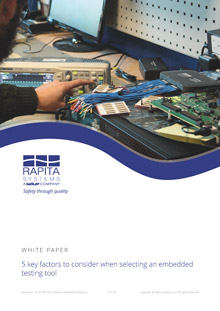Choosing a testing tool
DO-178C guidance is designed to ensure that clear best practices are defined and followed by avionics system developers. DO-178C guidance also prescribes specific software testing measures that are dependent on the criticality of the system in question.
There are a wide range of embedded testing tools available to safety-critical software developers that make expensive software testing significantly more efficient and cost-effective. This whitepaper describes 5 key factors that should be taken into consideration when making the important decision on which embedded testing tool to use for your project.
DO-178C Handbook
Adhering to DO-178C guidance, both in terms of development methodologies and testing requirements can be complicated and lots of potential pitfalls exist along the path.
'Efficient Verification Through the DO-178C Life Cycle' is a 70-page handbook (delivered by Rapita Systems and ConsuNova Inc.) that delivers valuable insights that will help both DO-178C beginners and experts to improve efficiency and reduce cost. Whatever your knowledge level, this guide could help you to improve your complete understanding of the DO-178C process, from planning to certification submission.

